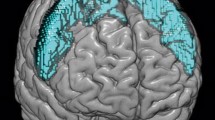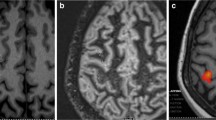Abstract
We compared the signal intensity of motor and sensory cortices on T2-weighted and FLAIR images obtained at 3T and 1.5T. MR images of 101 consecutive neurologically normal patients who underwent both 1.5T and 3T MRI were retrospectively evaluated. The signal intensities of motor and sensory cortices were analyzed both visually and quantitatively in comparison with superior frontal cortex. On T2-weighted images, decreased signal intensity of the motor cortex was seen in 6 (32%) of 19 patients aged 61–70 years and 14 (48%) of 29 at 71 years and older at 3T, compared with only 1 (5%) and 2 (7%) at 1.5T, respectively. On FLAIR images, the decreased signal intensity in the motor cortex was also more frequently seen at 3T than at 1.5T. The mean CNRs of motor and sensory cortices were significantly higher at 3T than at 1.5T on both T2-weighted and FLAIR images. The decreased signal intensity in the motor cortex was frequently seen at 3T compared with 1.5T. Knowledge of the finding at 3T can help the recognition of abnormalities of the motor cortex caused by various pathologic conditions.



Similar content being viewed by others
Abbreviations
- FLAIR:
-
fluid-attenuated inversion recovery
- SFC:
-
superior frontal cortex
- SNR:
-
signal-to-noise ratio
- FSE:
-
fast spin-echo
- CNR:
-
contrast-to-noise ratio
- ROI:
-
region of interest
References
Hirai T, Korogi Y, Sakamoto Y et al (1996) T2 shortening in the motor cortex: effect of aging and cerebrovascular disease. Radiology 199:799–803
Karaarslan E, Arslan A (2003) Perilorandic cortex of the normal brain: low signal intensity on Turbo FLAIR MR images. Radiology 227:538–541
Korogi Y, Hirai T, Komohara Y et al (1997) T2 shortening in the visual cortex: effect of aging and cerebrovascular disease. AJNR Am J Neuroradiol 18:711–714
Hirai T, Korogi Y, Yoshizumi K et al (2000) Limbic lobe of the human brain: evaluation with Turbo Fluid-attenuated inversion-recovery MR imaging. Radiology 215:470–475
Yoshiura T, Higano S, Rubio A et al (2000) Heschl and superior temporal gyri: low signal intensity of the cortex on T2-weighted MR images of the normal brain. Radiology 214:217–221
Georgiades CS, Itoh R, Golay X et al (2001) MR imaging of the human brain at 1.5T: regional variations in transverse relaxation rates in the cerebral cortex. AJNR Am J Neuroradiol 22:1732–1737
Alexander JA, Sheppard S, Davis PC et al (1996) Adult cerebrovascular disease: role of modified rapid fluid-attenuated inversion-recovery sequences. AJNR Am J Neuroradiol 17:1507–1513
Oba H, Araki T, Ohtomo K et al (1993) Amyotrophic lateral sclerosis: T2 shortening in motor cortex at MR imaging. Radiology 189:843–846
Imon Y, Yamaguchi S, Yamamura Y et al (1995) Low intensity areas observed on T2-weighted magnetic resonance imaging of the cerebral cortex in various neurological disease. J Neurol Sci 21:27–32
Russo C, Smoker WRK, Kubal W (1997) Cortical and subcortical T2 shortening in multiple sclerosis. AJNR Am J Neuroradiol 18:124–126
Miwa H, Kajimoto Y, Nakanishi I et al (2003) T2-low signal intensity in the cortex in multiple system atrophy. J Neurol Sci 211:85–88
Trattnig S, Pinker K, Ba-Ssalamah A, Nobauer-Huhmann IM (2006) The optimal use of contrast agents at high field MRI. Eur Radiol 16:1280–1287
Schwindt W, Kugel H, Bachmann R et al (2003) Magnetic resonance imaging protocols for examination of the neurocranium at 3T. Eur Radiol 13:2170–2179
Morakkabati-Spitz N, Gieseke J, Kuhl C et al (2006) MRI of the pelvis at 3T: very high spatial resolution with sensitivity encoding and flip-angle sweep technique in clinically acceptable scan time. Eur Radiol 16:634–641
Lemke AJ, Alai-Omid M, Hengst SA, Kazi I, Felix R (2006) Eye imaging with a 3.0-T MRI using a surface coil - a study on volunteers and initial patients with uveal melanoma. Eur Radiol 16:1084–1086
Bachmann R, Reilmann R, Schwindt W, Kugel H, Heindel W, Kramer S (2006) FLAIR imaging for multiple sclerosis: a comparative MR study at 1.5 and 3.0 Tesla. Eur Radiol 16:915–921
Stehling C, Vieth V, Bachmann R et al (2007) High-resolution magnetic resonance imaging of the temporomandibular joint: image quality at 1.5 and 3.0 Tesla in volunteers. Invest Radiol 42:428–434
Schenck JF, Zimmerman EA (2004) High-field magnetic resonance imaging of brain iron: birth of a biomarker? NMR Biomed 17:433–445
Bizzi A, Brooks RA, Brunetti A et al (1990) Role of iron and ferritin in MR imaging of the brain: a study in primates, at different field strengths. Radiology 177:59–65
Spatz H (1922) Uber den eisennachweis im gehirn, besonders in zentren des extrapyramidal-motorischen systems. Z Ges Neurol Psychiatry 77:261–390
Hallgren B, Sourander P (1958) The effect of age on the non-haemin iron in the human brain. J Neurochem 3:41–51
Norbash AM, Glover GH, Enzmann DR (1992) Intracerebral lesion contrast with spin-echo and fast spin-echo pulse sequence. Radiology 185:661–665
Welker KM, Tsuruda JS, Hadley JR et al (2001) Radio-frequency coil selection for MR imaging of the brain and skull base. Radiology 221:11–25
Stahl R, Dietrich O, Teipel SJ, Hampel H, Reiser MF, Schoenberg SO (2007) White matter damage in Alzheimer disease and mild cognitive impairment: assessment with diffusion-tensor MR imaging and parallel imaging techniques. Radiology 243:483–492
Sze G, Kawamura Y, Negishi C et al (1993) Fast spin-echo MR imaging of the cervical spine: influence of echo train length and echo spacing on image contrast and quality. AJNR Am J Neuroradiol 14:1203–1213
Author information
Authors and Affiliations
Corresponding author
Rights and permissions
About this article
Cite this article
Kamada, K., Kakeda, S., Ohnari, N. et al. Signal intensity of motor and sensory cortices on T2-weighted and FLAIR images: intraindividual comparison of 1.5T and 3T MRI. Eur Radiol 18, 2949–2955 (2008). https://doi.org/10.1007/s00330-008-1069-8
Received:
Revised:
Accepted:
Published:
Issue Date:
DOI: https://doi.org/10.1007/s00330-008-1069-8




